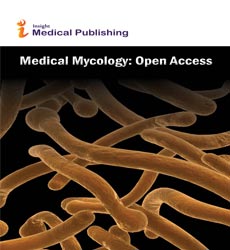Abstract
Superficial Mycoses in Menopausal Age Women: 21 years' Experience
Background: Menopause is the permanent and irreversible absence of menstruation for at least a year. Usually, it is accompanied by typical physical and mental symptoms. Although, infections during menopause have been extensively documented, there is a lack of information regarding superficial mycoses.
Objective: Our objective was to determine the frequency of superficial mycoses in menopausal age women.
Methods: This is a retrospective chart review of menopausal age patients seen at the Mycology section in a single medical institution in Mexico City from 1994 to 2014. Clinical, epidemiological, and mycological data were reviewed.
Results: There were 881 patients studied and 811 cases were confirmed by a mycological test. Diagnoses in menopausal age women included onychomycosis (84.5%), tinea pedis (25.6%), candidiasis (7.8%), and tinea corporis (4.3%). The most common presentations of onychomycosis were distal and lateral subungueal (29.7%) and total dystrophic (32.2%). In 36.7% the diagnosis was simply “onychomycosis”. The most common etiologic agents in onychomycosis were Trichophyton rubrum (39.8%) and Candida spp. (45.3%). The most common etiologic agent in tinea corporis and pedis was T. rubrum. The types of candidiasis were interdigital (29.6%), oral (45.3%), and intertrigo (17.1%). The most common isolates were Candida spp. (55.5%) and C. albicans (29.6%).
Author(s):
Arenas R, Guevara-Cervantes Javier F, Perez-Rojas Diego O, and Vasquez-del-Mercado E
Abstract | Full-Text | PDF
Share this

Google scholar citation report
Citations : 164
Medical Mycology: Open Access received 164 citations as per google scholar report
Abstracted/Indexed in
- Google Scholar
- China National Knowledge Infrastructure (CNKI)
- Directory of Research Journal Indexing (DRJI)
- WorldCat
- Publons
- Geneva Foundation for Medical Education and Research
- Secret Search Engine Labs
Open Access Journals
- Aquaculture & Veterinary Science
- Chemistry & Chemical Sciences
- Clinical Sciences
- Engineering
- General Science
- Genetics & Molecular Biology
- Health Care & Nursing
- Immunology & Microbiology
- Materials Science
- Mathematics & Physics
- Medical Sciences
- Neurology & Psychiatry
- Oncology & Cancer Science
- Pharmaceutical Sciences
